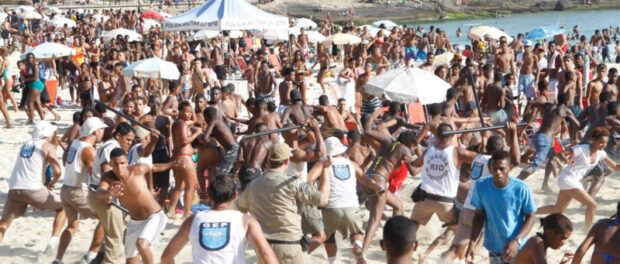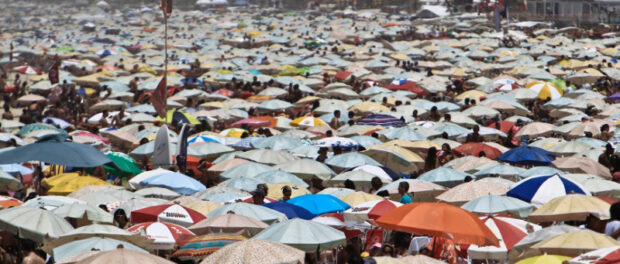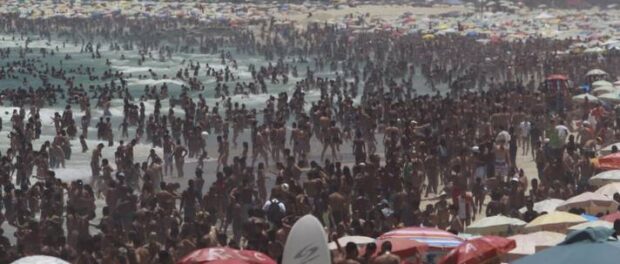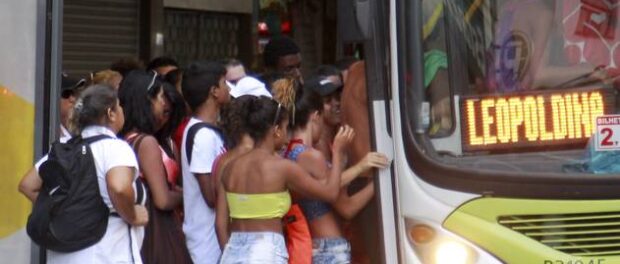
Many thousands of Rio residents packed the beaches of South Zone last Wednesday November 20, Black Awareness Day and a public holiday in Rio state. However, some sunbathers who squeezed onto the sand to enjoy the scorching temperatures were victims of a series of robberies as opportunistic thieves took advantage of the dense holiday crowds. Municipal guards armed with batons confronted and apprehended several youngsters, and the military police made 12 arrests.
The following day Globo reported the incident with the opening line: “The mass robberies are back on Rio’s beaches.” Though the Military Police denied that what had occurred that day were arrastões, as mass robberies are known in Brazil, the seeming rise in beach robberies in recent weeks–another mass robbery was reported on November 15, also a public holiday–has caused panic over security on the sand.
In response, Rio State Security Secretary José Mariano Beltrame announced on Friday November 22 new measures of “intensive policing” along the South Zone beaches and that buses heading from the city’s North Zone to the beach neighborhoods of Copacabana, Ipanema and Leblon will be stopped and searched. Passengers may be asked to show their documents and children under 10 unaccompanied by an adult taken to a shelter.
The announcement has caused widespread outrage on social media, with the Globo report shared extensively on Facebook and tweeted hundreds of times. One of the most common reactions to the news has been disgust and disbelief with many comments simply stating “is this serious?” or “this is unbelievable.”
Sharing on Facebook, community photographer and educator, Léo Lima from Jacarezinho wrote: “It’s impossible to believe this news. This is called racism, for those that thought that was over. This is called the divided city, the elitization of the public space. With no measures to contain mass robberies, the police blame the suburbs.” The implication that those responsible for beach robberies come from the North Zone was highlighted by many, including Revista Absurda which tweeted: “The Rio summer trend this year is ‘There are only criminals in the North Zone.'”
The divisory tactic shocked many commentators, who tweeted the report with the words “Apartheid Carioca.” Others referred to the strategy creating ghettos and cementing existing divisions between the North and South of the city. Raull Santiago, photographer, activist and member of the Occupy Alemão collective, posted the comment: “It’s happened. They’ve marginalized the whole of the North Zone. The previously invisible wall is starting to consolidate!”
Others referred to the wider context of policies and government action limiting civil rights as the city prepares to host the World Cup 2014 and Olympics 2016. Sharing the link, the Vila Cruzeiro Facebook page wrote: “The state of exception: maintaining ‘security’ for the gringos. Residents of the North Zone will suffer yet another attack on their rights.” The Network Against Violence also cited the strategy as part of the state of exception, writing: “There’s nothing left to complete the state of exception in Rio de Janeiro: militias, police incursions, UPPs, compulsory internment, arbitrary removals and now the control over the circulation of the young, black and poor.” The affront to the right of North Zone residents to come and go explicit in the move was reiterated across Facebook and Twitter.
Beach robberies and subsequent measures to stop and search buses coming from the North Zone are not without precedent. As with violent crime in general, mass robberies on the beaches were most intense in Rio during the 1990s, in particular the wave of arrastões which made national and international headlines in 1992. The measure subsequently taken was to control the flow of those coming from the suburbs to the South Zone, stopping and searching buses in Centro and at the embarkment points in the North Zone: “Those without ID, shirt or money for the return journey will not be able to embark on buses from the North Zone and Centro to the South Zone on weekends and sunny public holidays,” reported Globo on October 22, 1992.
Conflating geography and class with criminality is a popular, long-time conception among Rio residents, particularly those living in the wealthy, beachside neighborhoods. In 1984, the first bus line to pass through the Rebouças tunnel linking the North and South of the city caused widespread concern amongst the beachside resident elites who looked with thorough disdain on the neighborhoods’ new frequenters – dubbed farofeiros after the manioc flour accompaniment poorer beachgoers bring with their packed lunches. Residents’ comments at the time published in the Jornal do Brasil column, Caderno B, included: “What ugly people;” “They’re creating a scene of vandalism and terror;” “The beach has changed color;” and “We pay such expensive taxes for them to put this poverty on our doorstep.”
Three decades later, the same attitudes can still be heard amongst South Zone residents in resistance to the new metro stations in Ipanema and Leblon and increased bus lines. One Ipanema resident posted on Facebook last Wednesday: “It’s not possible for residents who pay the most expensive property tax in the country to go out on the streets or the beach in peace. It’s terrifying. No prejudice, but it’s not possible to have a bus every 15 minutes going to Alemão.” It received at least 45 likes and 20 supportive comments including a call for a petition in favor of reducing transport access, but the post was also shared in outrage by residents from Alemão including editor-in-chief of the Voice of the Communities newspaper, Rene Silva, who shared it several times. The author later withdrew the post.
Rio’s beaches are commonly lauded as democratic spaces where the whole, varied spectrum of Rio society mixes and co-exists. However as anthropologist Fernanda Pacheco da Silva argues in her 2011 study ‘The beaches of Ipanema: liminality and proxemics of the seashore,’ there are distinct urban tribes which occupy distinct locations along the South Zone coast. Though interaction may fall far short than the imagined democratic utopia, however, access to the beach is part of the right to the city, particularly given Rio’s beaches’ role as the city’s quintessential public space. Pacheco da Silva cites an interview with Patrícia Farias, author of ‘Getting some color on the beach: race relations and classifications of color in Rio de Janeiro,‘ who says of Rio residents’ habit of going to the beach: “it’s important not just as a sign of status, or being at leisure, but because you want to say something, that you are in the city too.””
That some residents of beachside neighborhoods feel their high tax contributions entitle them to more exclusive access to Rio’s shores and are sanctioned in this view by government strategies which implicate the North Zone as the source of beach insecurity threatens the right to the beach for all. Further still, by distorting the discussion, the city-wide security problem in which street robberies and carjacking have risen goes unaddressed. One blogger on Comunica Tudo writes: “What should have been about public security, education, mobility, leisure and distribution of wealth has been transformed into a neighborhood-focused, segregationist, racist and prejudiced issue.”
The author continues: “There’s a clear difference between buying a house in Leblon and buying a beach in Leblon. This means that by buying a house in Leblon you haven’t bought the whole beach with it. Your house is a private space, but the streets and beach in Leblon are public spaces, destined for public use be it by residents of the South Zone, West Zone or North Zone, or foreigners, tourists and so on.”
Rejecting that the North Zone’s right to the beach be compromised, Occupy Alemão has created a Facebook event “Farofaço – WE are going to invade OUR beach” inviting fellow North Zone residents on a mass day out: “Like the good Cariocas we are, how about we take advantage of the weekend rest to enjoy the beach hey? After all, we work and pay taxes too! And it won’t be the South Zone crew or Beltrame who are going to tell us what our fun should be!” Following a list of classic recommended items to bring – “Don’t forget your phones and cameras! Because we have our technology and we guarantee, we don’t need to steal from anyone!” – the event description ends with an invitation: “Those who live in the South Zone, come too! The beach is everyone’s and we all work on Monday.”




